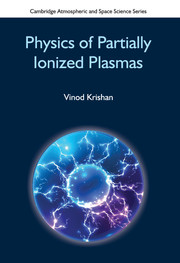Book contents
- Frontmatter
- Dedication
- Contents
- Figures
- Preface
- 1 Partially Ionized Plasmas Here and Everywhere
- 2 Multiflkuid Description of Partially Ionized Plasmas
- 3 Equilibrium of Partially Ionized Plasmas
- 4 Waves in Partially Ionized Plasmas
- 5 Advanced Topics in Partially Ionized Plasmas
- 6 Research Problems in Partially Ionized Plasmas
- Supplementary Matter
- Index
5 - Advanced Topics in Partially Ionized Plasmas
Published online by Cambridge University Press: 13 September 2017
- Frontmatter
- Dedication
- Contents
- Figures
- Preface
- 1 Partially Ionized Plasmas Here and Everywhere
- 2 Multiflkuid Description of Partially Ionized Plasmas
- 3 Equilibrium of Partially Ionized Plasmas
- 4 Waves in Partially Ionized Plasmas
- 5 Advanced Topics in Partially Ionized Plasmas
- 6 Research Problems in Partially Ionized Plasmas
- Supplementary Matter
- Index
Summary
In this chapter, we shall attempt to introduce the reader to some specific issues arising in partially ionized plasmas as they exist in varied astrophysical sites. We have taken the solar atmosphere as a prime example, as it spans a wide range of plasma parameters which present circumstances for suitable application of the four different descriptions of a partially ionized plasma. A variety of issues such as the equilibrium, the waves and the instabilities giving rise to turbulence, summon our attention. A few examples of the equilibrium states of a partially ionized plasma in its different descriptions have been presented in Chapter 3.
Here, we shall explore in some detail the existence of equilibrium structures, including gravitational, rotational, magnetic and multifluid effects. The Hall equilibrium of the partially ionized plasma, in particular, brings out a new spatial scale which is larger than the ion inertial scale. The double curl nature of the solutions maps the velocity and the magnetic field on short spatial scales. The equilibrium of the partially ionized plasma under the dominance of the ambipolar effect reveals the existence of extremely sharp magnetic structures embedding large current densities. Such structures enable the heating of the plasma through the excitation and saturation of plasma instabilities.
Equilibrium of Partially Ionized Structures in the Solar Atmosphere
The solar atmosphere consists of layers which widely differ in their density, temperature and magnetization properties. While the distribution of the atmospheric matter consisting of neutral hydrogen, hydrogen plasma and ions of various elements is essentially a result of the gravitational stratification, the temperature and the magnetic field variations are extremely large being governed by the local energetics. The outermost layer called the solar corona becomes visible only during solar eclipses. It is at a temperature of more than a million degree Kelvin and consists of a fully ionized hydrogen plasma and trace ions, such as iron and calcium, in various states of ionization. The next identifiable layers are respectively the transition region and the chromosphere. The chromosphere has a temperature of tens of thousands of degree Kelvin and rises to a million degree Kelvin in the very narrow transition region. The next lower layer is the photosphere. It is the layer from which we receive the visible radiation. The colour of the visible radiation (a near yellow) tells us that the photosphere is approximately at a temperature of 6000 degree Kelvin.
- Type
- Chapter
- Information
- Physics of Partially Ionized Plasmas , pp. 184 - 243Publisher: Cambridge University PressPrint publication year: 2016



